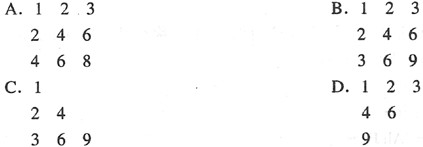单选题有程序:INTEGERM(3,3)DATAM/1,2,3,4,5,6,7,8,9/DO10I=1.3DO10J=1,3K=M(I,J)M(I,J)=M(J,I)M(J,I)=K10CONTINUEWRITE(*,100)((M(I,J),J=1,3),I=1,3)100FORMAT(1x,3I2)END此程序执行后的结果为:()A 1;4;7;2;5;8;3;6;9B 1;2;3;4;5;6;7;8;9C 9;6;3;8;5;2;7;4;1D 7;8;9;4;5;6;1;2;3
题目
1;4;7;2;5;8;3;6;9
1;2;3;4;5;6;7;8;9
9;6;3;8;5;2;7;4;1
7;8;9;4;5;6;1;2;3
相似问题和答案
第1题:
阅读下列程序。
Option Base 1
Private Sub Form. Click()
Dim x(3,3)
For j=l to 3
For k=l to 3
If j=k then x(j,k)=l
If j<>k then x(j,k)=k
Next k
Next j
Call fun(x())
End Sub
Private Sub fun(x() )
For j=1 to 3
For k=1 to 3
Print x(j,k);
Next k
Next j
End Sub
运行程序时,输出结果为【 】
1 2 311 3 1 21 解析:本题考查考生对数组虚实结合掌握的情况。事件过程声明了一个二维数组,并利用循环产生3*3数组,由题干可知,该数组对角线元素全部为1,其余元素为3。调用fun过程时,采用了虚实结合的方法,然后执行该过程。在过程中访问x数组就是事件过程中的数组,优先输出了x数组的所有元素值,由于在输出时执行了Print x(j,k),并且输出数据语句后有分号,因此只输出一行。
第2题:
下面程序输出的是( )。 main { int t=l;fun(fun(t));} fun(int h) { static int a[3]={1.2.3}; int k; for(k=0;k<3;k++)a[k]+=a[k]-h; for(k=0;k<3;k++)printf("%d",a[k]); printf("\n"); return(a[h]);}
A.1,2,3, 1,5,9,
B.1,3,5, 1,3,j,
C.1,3,5, 0,4,8,
D.1,3。5, -1,3,7,
本题考查双重函数调用及for循环使用,fun函数中第一个for循环语句的作用是给数组a赋值。当第一次调用fun函数时,把实参1传给形参,输出a数组的元素为1,3,5;第二次调用fun函数时,由于数组a为静态局部变量,故输出a数组的元素为一1,3,7。
第3题:
有以下程序:void main(){ int k=10,n=0; for(;n<k;) { //n++; if(n++%3!=0)continue; k--; } printf("%d,%d\n",k,n);}程序运行后的输出结果是( )。A.7,7 B.6,6 C.3,3 D.4,4
//说明后面的为注释,不执行。当n=0,3,6的时候,执行k--,即10-3=7,而n=6,执行判断n++%3!=0时,自增为7,再执行判断n<k时,不成立,退出循环。
第4题:
在AutoCAD中,相对于点(1,3),点(3,3)的相对极坐标表示为()
A.@3<0
B.@
C.@2<0
D.@2<180
第5题:
有以下程序: #include <stdio.h> main() { int k=4,n=0; for( ;n<k;) { n++; if(n%3! =0) continue; k--;} printf("%d,%d\n",k,n); } 程序运行后的输出结果是( )。
A.1,1
B.2,2
C.3,3
D.4,4
解析:本题考查循环和continue语句,continue语句的功能是结束本次循环。n从0开始循环,判断n%3!=0是否成立,如果成立,结束本次循环,继续下一次for循环;否则执行k--,并继续下一次for循环,直至循环结束。在程序中,当n取1,2时,不执行k--,当n取3时,执行k--,k变为3,循环结束,输出k,n的值分别为3,3。
第6题:
有以下程序
main( )
{ int k=4,n=0;
for( ; n<k ; )
{ n++;
if(n%3!=0) continue;
k--; }
printf("%d,%d\n",k,n);
}
程序运行后的输出结果是
A.1,1
B.2,2
C.3,3
D.4,4
解析:此题考查了循环体内条件语句的用法,同时考查了continue在循环中的作用,即当执行到continue时,不再执行循环体中尚未执行的语句,而直接跳转到for语句中执行表达式3(本程序中为空),再判断nk是否成立。
第7题:
3下面程序的运行结果是( )。
Option Base 1
Private Sub Commandl_Crick()
Dimx,y(3,3)
x=Array(1,2,3,4,5,6,7,8,9)
Fori=1 To 3
Forj=1 To 3
y(i,j)=(i*j)
If(j>=i)Then Printy(i,j);
Nextj
Nexti
End Sub

A.
B.
C.
D.
第8题:
有如下程序:
Private Sub Command1_Click()
Dim k As Integer, m As Integer
Dim p As Integer
k=4: m=1
p=PC(k, m) : Print p;
p=PC(k, m) : Print p
End Sub
Private Function PC(a As Integer, b As Integer)
Static m As Integer, i As Integer
m=0: i=2
i=i + m + 1
m=i + a + b
PC=m
End Function
程序运行后,输出的结果为( )。
A.4 6
B.6 6
C.8 8
D.10 12
第9题:
下列程序的输出结果是( )。 #include<iostream> using namespace std; int main(){ int x[6]={1,3,5,7,9,11},*k,**s; k=x; s=&k; cout<< *(k++) <<"," << **s<<endl; return 0; }
A.3,3
B.1,1
C.3,5
D.1,3
解析:本题考核指针数组之间的关系。指针k指向x数组的首地址,指针型指针s指向了指针变量k。另外,“++”作为后缀时,要等整个表达式执行完毕后再执行自增运算。所以,输出结果为1,1。
第10题:
A.13
B.16
C.17
D.45
解析:数组a中的元素为:a[0]=1,a[1]=2,…,a[8]=9。k=0时,s=s+*(a+0)=0+1=1;k=2时,s=1+*(a+2)=1+3=4;k=4时,s=4+5=9;k=6时,s=9+7=16。
